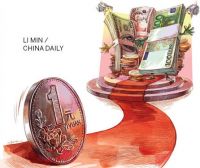
China has to wait for one more year to include the Renminbi under the IMF’s SDR basket. A decision on this has been taken by the IMF on Tuesday, indicating that the Fund will introduce any change only by September 2016.
The SDR (Special Drawing Rights) is the reserve asset of the IMF and its value depends upon a basket comprised of the four important global currencies- the US Dollar, the Euro, British Pound Sterling and the Japanese Yen.
China has been insisting on every global front that the IMF should reform the currency basket by including its currency – the Renminbi.
Inclusion of Renminbi is an indicator of the rising status of the Chinese economy and a big step towards the internationalization of the Renminbi.
Informal reports indicate that the Chinese currency is increasingly used for international transactions and it is considered to be the second most preferred currency after the US Dollar.
High trade share of China and Beijing’s increasing efforts to settle trade in Renminbi have made the Renminbi even more international in the last few years.
The criteria for SDR basket was last updated in 2000. The IMF’s policy prescribes to revise it in every five years so as to accommodate new heavy weight currencies. But rarely new currencies are emerging and in 2010, the IMF has declined to include Renminbi in the basket.
Thereafter, Beijing was heavily criticizing the IMF order demanding reform of the institution. Most importantly, the formation of NDB and AIIB has added pressure on the West controlled Fund to consider the candidature of Renminbi.
At the same time, Chinese currency needs some more adjustments to be recognized as a world currency. Its merit is that it is widely used in international trade but least used as a reserve currency by central banks because of inadequate reforms in its bond market.
“To a certain extent, the delay in the adoption is meant to urge China to speed up its capital accounts liberalization once the yuan is approved as a reserve currency,” Zhou Yu, director of the Research Center of International Finance at the Shanghai Academy of Social Sciences, was quoted by the Global Times.
There are two important criteria to determine whether a currency is eligible to be included as a reserve currency. First one is the export criterion. This criterion ensures that currencies that qualify for the basket are those issued by members/currency unions that play a central role in the global economy.
According to Siddharth Tiwari, director of the IMF’s Strategy, Policy and Review Department, the renminbi (RMB) is the only currency not currently in the SDR basket that meets the export criterion. Therefore, a key focus of the current review will be whether the RMB also meets the freely usable criterion in order to be included in the SDR basket.
The second criterion is that the currency should be a “freely usable” currency. This means that the said currency is widely used to make payments for international transactions and is widely traded in the principal exchange markets.
Though the Chinese currency is well qualified on the first criterion; reforms are to be made to realize the second one.
*********










